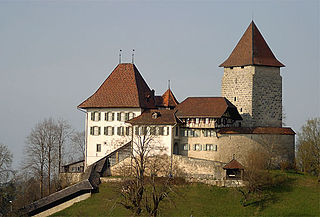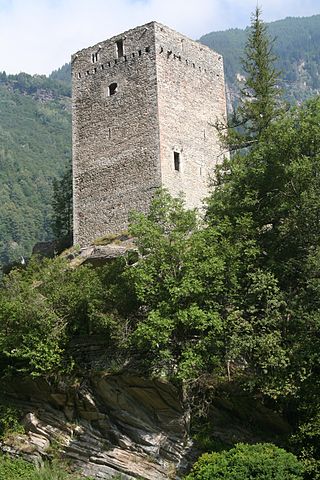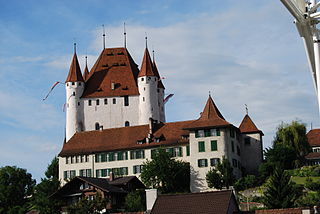
Lenzburg Castle is a castle located above the old part of the town of Lenzburg in the Canton of Aargau, Switzerland. It ranks among the oldest and most important of Switzerland. The castle stands on the almost circular castle hill, which rises approximately 100 m (330 ft) over the surrounding plain but is only about 250 m (820 ft) in diameter. The oldest parts of the castle date to the 11th century, when the Counts of Lenzburg built it as their seat. The castle, its historical museum and the castle hill with its Neolithic burial grounds are listed as heritage sites of national significance.

Trachselwald Castle is a castle in the municipality of Trachselwald in the canton of Bern, Switzerland. It is a Swiss heritage site of national significance.

The Old City is the medieval city center of Bern, Switzerland. Built on a narrow hill bordered on three sides by the river Aare, its compact layout has remained essentially unchanged since its construction during the twelfth to the fifteenth century. Despite a major fire in 1405, after which much of the city was rebuilt in sandstone, and substantial construction efforts in the eighteenth century, Bern's old city has retained its medieval character.

Wil Castle is a castle from the 13th and 16th century in the municipality of Schlosswil in the Canton of Bern, Switzerland. The castle is a popular destination for locals and is a Heritage Site of National Significance. It was the administrative seat of the Konolfingen District.

Pfäffikon Castle is a castle in the municipality of Freienbach of the Canton of Schwyz in Switzerland. It is a Swiss heritage site of national significance.

Castelmur Castle is a castle in the village of Bondo in the municipality of Bregaglia of the Canton of Graubünden in Switzerland. It is a Swiss heritage site of national significance. The fortifications at Castelmur may be, after the Three Castles of Bellinzona, the most important example of medieval valley fortifications in modern Switzerland.

Brandis Castle or Maienfeld Castle is a castle in the municipality of Maienfeld of the Canton of Graubünden in Switzerland. It is a Swiss heritage site of national significance.

Rietberg Castle is a castle in the municipality of Pratval of the Canton of Graubünden in Switzerland. It is a Swiss heritage site of national significance. It was the site of the murder of Pompeius Planta in 1621 by Jörg Jenatsch during the conflicts between Catholics and Protestants known as the Bündner Wirren.

Amsoldingen Castle is a castle in the municipality of Amsoldingen in the canton of Bern in Switzerland. The castle and associated former collegiate church of St. Mauritius are a Swiss heritage site of national significance.

Köniz Castle is a castle in the municipality of Köniz of the Canton of Bern in Switzerland. It is a Swiss heritage site of national significance.

Nidau Castle is a castle in the municipality of Nidau of the Canton of Bern in Switzerland. It is a Swiss heritage site of national significance.

Oberhofen Castle is a castle in the municipality of Oberhofen of the Canton of Bern in Switzerland. It is a Swiss heritage site of national significance.

Spiez Castle is a castle in the municipality of Spiez of the Swiss canton of Bern. It is a Swiss heritage site of national significance.

Thun Castle is a castle in the city of Thun, in the Swiss canton of Bern. It was built in the 12th century, today houses the Thun Castle museum, and is a Swiss heritage site of national significance.

The Altes Schloss Bümpliz is a castle in the section of Bümpliz-Oberbottigen in the city of Bern of the canton of Bern in Switzerland.

Allmendingen Castle is a castle in the municipality of Allmendingen of the canton of Bern in Switzerland.

Mülenen Castle and the attached Letzi Mülenen wall are a ruined medieval fortification in the village of Mülenen and municipality of Reichenbach im Kandertal, in the Swiss canton of Bern. The Letzi Mülenen is a Swiss heritage site of national significance.

Uster Castle is a hill castle which was built probably around 1200 AD by the House of Rapperswil in the Swiss municipality of Uster in the Canton of Zürich. Since 1995 it houses a boarding school.

Trostburg Castle is a small castle in the municipality of Teufenthal in the canton of Aargau in Switzerland.

The Bern Town Hall is the building in Bern, Switzerland that houses the Grand Council of Bern, the Executive Council of Bern and the Grand Council of the City of Bern. The building is part of the UNESCO World Heritage Site of the Old City of Berne and is a Swiss heritage site of national significance.





















